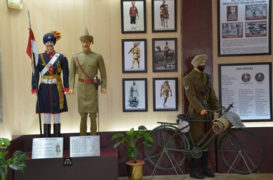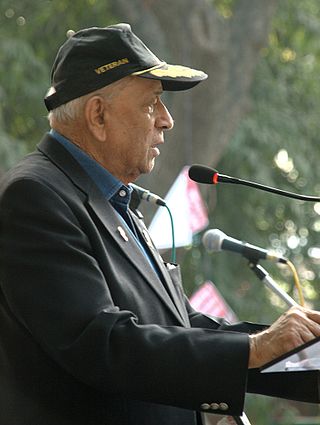
Admiral Laxminarayan Ramdas, PVSM, AVSM, VrC, VSM, ADC was an Indian naval officer who was a flag officer of the Indian Navy. Ramdas first served in the Indian Navy in 1953, before being promoted as a flag lieutenant to Ram Dass Katari, the first Indian Chief of the Naval Staff Admiral. In the Indo-Pakistani war of 1971, he was involved in a naval blockade of East Pakistan, hindering attempts to evacuate 93,000 troops and leading to East Pakistan's surrender. During his service in the military confrontation, he was awarded the Vir Chakra. Ramdas later served as the 13th Chief of Naval Staff from 1990 to 1993.

The Kumaon Regiment is one of the oldest infantry regiments of the Indian Army. The regiment traces its origins to the 18th century and has fought in every major campaign of the British Indian Army and the Indian Army, including the two world wars, and is one of the highest decorated regiments of the Indian Army.
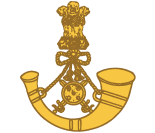
The Maratha Light Infantry is a light infantry regiment of the Indian Army. It traces its lineage to the Bombay Sepoys, raised in 1768, making it the most senior light infantry regiment in the Indian Army.

The Poona Horse is an armoured regiment in the Armoured Corps of the Indian Army. The regiment, known before independence as The Poona Horse, was raised as a regular cavalry regiment in the Bombay Presidency army of the East India Company. It was formed from the 3rd Regiment of Bombay Light Cavalry, raised in 1820, and the Poona Auxiliary Horse, raised about 1817–18. The latter unit was absorbed into the regular forces about 1860 and the two regiments later became the 33rd Queen Victoria's Own Light Cavalry and the 34th Prince Albert Victor's Own Poona Horse.
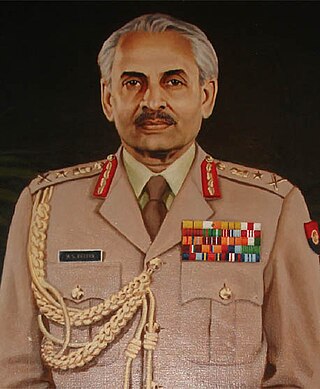
General Arunkumar Shridhar VaidyaPVSM, MVC & Bar, AVSM, ADC was an Indian Army general. He served as the 12th Chief of the Army Staff from 1983 to 1986. Following his retirement, he was assassinated by Harjinder Singh Jinda and Sukhdev Singh Sukha in August 1986, for his role in Operation Blue Star in 1984.

The Garhwal Rifles, formerly known as the Royal Garhwal Rifles, are an infantry regiment of the Indian Army. It was originally raised in 1887 as the 39th (Garhwal) Regiment of the Bengal Army. It then became part of the British Indian Army, and after the Independence of India, it was incorporated into the Indian Army.

XII Corps is a corps of the Indian Army and one of the two corps of the Pune-based Southern Command. XII Corps is also known as Konark Corps/Desert Corps.
Lieutenant General Khem Karan Singh, MVC was an Indian senior military officer. He was awarded the Padma Bhushan for his role in the 1971 Indo-Pakistani War. He also received the Maha Vir Chakra for his services during the Indo-Pakistani war of 1965.
20th Lancers is an armoured regiment in the Armoured Corps of the Indian Army. The regiment distinguished itself in operations with its defence of Chhamb in Jammu and Kashmir during the 1965 Indo-Pakistan War and won one Maha Vir Chakra. It has provided one Chief of Army Staff and two Army Commanders.

Lieutenant General Yogesh Kumar Joshi, PVSM, UYSM, AVSM, VrC, SM, ADC is a retired General Officer of the Indian Army. He was the General Officer Commanding-in-Chief Northern Command, assuming office from Lt Gen Ranbir Singh on 1 February 2020. He last served as the Chief of staff of the Northern Command, assuming the office from Lt Gen SK Sharma. Previously, he was the commander of Leh based Fire & Fury Corps. As Army Commander he is credited with spearheading the Indian response to PLA's attempt to alter the status quo on Line of Actual Control (LAC) by use of force. He is the only war decorated Army Commander who has to his credit successes against both Indian adversaries China and Pakistan.
Lieutenant General Bobby Mathews, PVSM, AVSM & Bar, VSM is an Indian Army officer who is an alumnus of the prestigious National Defence Academy, Khadakwasla. He is a second generation army officer and has been General Officer Commanding of the Konark Corps, India's only Desert Corps. The General holds a MSc & MPhil Degree from Madras University.

Lieutenant General Raj Mohan Vohra, PVSM, MVC was a General Officer of the Indian Army. He was awarded the Maha Vir Chakra for his bravery and leadership in the Battle of Basantar during the Indo-Pakistani War of 1971.
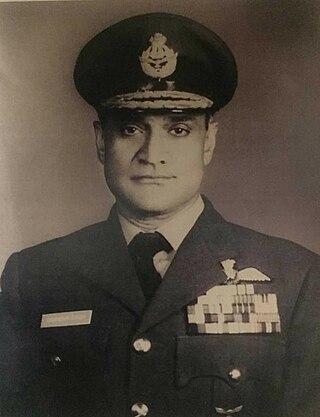
Air Vice Marshal Chandan Singh, MVC, AVSM, VrC was an Air Officer in the Indian Air Force. A highly decorated officer, Singh was awarded the Vir Chakra during the Sino-Indian War and the Maha Vir Chakra during the Indo-Pakistani War of 1971.
Major General Harish Chandra Pathak, MVC, AVSM was an officer of the Indian Army, who belonged to the SikhLI Regiment. He was awarded the Maha Vir Chakra, India's second highest award for gallantry in the face of the enemy, during Battle of Fatehpur, Indo-Pakistan War of 1971.
Lieutenant General Joginder Singh Bakshi MVC, VSM was a General Officer in the Indian Army. He was decorated with the Maha Vir Chakra for his role in the Indo-Pakistani War of 1971.
26 Air Defence Regiment is an Air Defence regiment of the Indian Army.
Major General Dalvir Singh AVSM, VrC, VSM is a retired Indian Special Forces officer, a former General Officer of the Indian Army and the recipient of Vir Chakra, India's third-highest War-time gallantry award. He has commanded the 10th Battalion Special Forces, the elite 52 Special Action Group of the NSG, Kilo Force of the Rashtriya Rifles and the Territorial Army (India), with distinction. After retirement from active military service, he has been serving as the Director Training of Rajasthan Police Training Center Jodhpur.
101 Field Regiment is part of the Regiment of Artillery of the Indian Army.
94 Field Regiment is part of the Regiment of Artillery of the Indian Army.
42 Medium Regiment (Dera Baba Nanak) is part of the Regiment of Artillery of the Indian Army.







